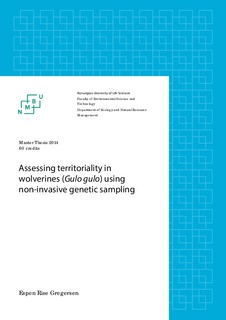| dc.contributor.author | Gregersen, Espen Rise | |
| dc.date.accessioned | 2014-09-17T09:28:47Z | |
| dc.date.available | 2014-09-17T09:28:47Z | |
| dc.date.available | 2014 | |
| dc.date.issued | 2014-09-17 | |
| dc.identifier.uri | http://hdl.handle.net/11250/220186 | |
| dc.description.abstract | Monitoring rare and elusive animals, such as large carnivores, is difficult and expensive. Non-invasive genetic sampling (NGS) has become a popular monitoring method, since it allows for spatial and genetic studies of rare and elusive species. The main objective of my research is to assess the home ranges, territoriality and potential turnover in wolverines.
The main study area for my thesis is located within the wolverine’s distribution range in Southern Norway. Altogether, 2250 noninvasively scat samples were collected, which were attributable to 288 individual wolverines. NGS with GPS derived home ranges were compared to assess NGS reliability. For 32 individuals, I estimate multiple-year home ranges using NGS scat samples. Using approaches similar to resource selection function (RSF), I assessed territory exclusion (and avoidance) of conspecifics and tested for diminished or eliminated exclusion after a territory owner died.
I show a consistency between NGS and GPS derived home ranges with a high degree of overlap. Patterns in spatial arrangement of wolverine scats suggested that wolverine exclude conspecifics from their home range. General linear mixed models (GLMM) revealed that scats from male wolverines were less likely to be located inside another male’s home range, and the effect is also detected for the female:female case. I did not find evidence of exclusion between the two sexes, suggesting that there is intersexual tolerance in wolverines. GLMM strongly indicate that there is diminished exclusion of conspecifics of the same sex after the territory owner dies.
A comparison with telemetry data (GPS) showed that that NGS can be a reliable method for evaluating spatial patterns in wolverine. My results are indicative of intrasexual territoriality in wolverines. Wolverines were found to begin using vacant territories after the territory owner´s death, meeting a requirement for eventual territory turnover and suggesting that wolverines are able to quickly fill gaps in the species distribution range. It is noteworthy that patterns of territoriality were pronounced enough to be detected using scat-based NGS data. This suggest that NGS is a sensitive and useful method for monitoring of elusive and rare animals. | nb_NO |
| dc.language.iso | eng | nb_NO |
| dc.publisher | Norwegian University of Life Sciences, Ås | |
| dc.subject | Spatial ecology | nb_NO |
| dc.subject | Wolverine; Gulo gulo | nb_NO |
| dc.subject | Non-invasive genetic sampling; NGS | nb_NO |
| dc.title | Assessing territoriality in wolverines (Gulo gulo) using non-invasive genetic sampling | nb_NO |
| dc.title.alternative | Territorialitet hos jerv (Gulo gulo) undersøkt med ikke-invasiv genetisk analyse | nb_NO |
| dc.type | Master thesis | nb_NO |
| dc.subject.nsi | VDP::Mathematics and natural science: 400::Zoology and botany: 480::Ecology: 488 | nb_NO |
| dc.source.pagenumber | 39 | nb_NO |
| dc.description.localcode | M-ECOL | nb_NO |
